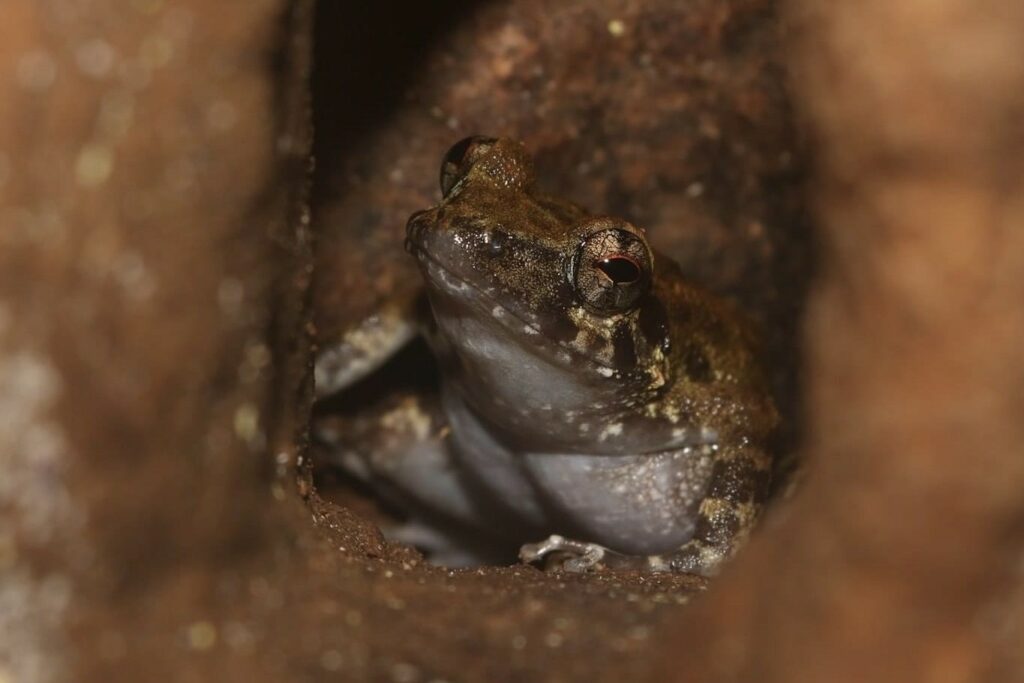Nestled within the diverse landscapes of Central Luzon, the province of Bulacan is home to a remarkable sanctuary of historical significance and ecological marvels: Biak-na-Bato National Park.
Spanning over 2,000 hectares in San Miguel town, this natural treasure epitomizes the interconnectedness of humanity and the environment, resonating with a profound call for biodiversity conservation and sustainable natural resources management.
Legacy of resistance and conservation
Once a bastion of resistance against colonial oppression, this national park bears witness to the valor of Filipino revolutionaries. It served as the headquarters of President Emilio Aguinaldo during the tumultuous years of the Philippine Revolution, where pivotal events such as the signing of the Biak-na-Bato Pact marked significant milestones in the country’s quest for independence.

The Luzon Limestone Forest Frog (Platymantis biak) perches atop limestone formations or guards cave entrances within the Biak-na-Bato National Park in Bulacan, deriving its name from this protected area where it is endemic. (DENR Region 3)
Today, amidst the echoes of the past, Biak-na-Bato stands as a beacon of hope for biodiversity conservation. Its labyrinthine cave networks, crystalline formations, and lush forests harbor a wealth of flora and fauna, including endangered species like the Philippine deer and various bat populations.
Yet, the park’s ecological splendor is not without threats, as habitat destruction and wildlife trafficking loom as ominous shadows.
Youth as agents of change
Recently, the Philippine Information Agency (PIA) regional office in Central Luzon, in collaboration with the Department of Environment and Natural Resources (DENR), organized the Kilos Kabataan para sa Saribuhay [Biodiversity] virtual youth forum. This initiative aimed to rally the youth in safeguarding biodiversity and natural resources.
About 80 students from Bulacan Polytechnic College and Richwell Colleges, Inc. participated in the third leg of the forum.
During the activity, DENR Communications Development Officer Joshua Rei Ubaldo underscored the vital importance of understanding the interconnectivity of life.
“As I’ve said, all of us are interconnected. Once you remove one species or once you stop taking care of one species, all of us will experience the impact,” he pressed.

Ubaldo also rallied support for clean-up drives, stressing their importance in sustaining marine ecosystems.
“Any harm done to nature will backfire on us. So what should we do? We should plant trees, let’s continue planting endemic trees and take care of our biodiversity,” he further explained.
He urged participants to cultivate a deep appreciation for biodiversity, underscoring the need to protect all ecosystems, from forests to marine environments, through a holistic “ridge to reef” approach.
In his message to participants, PIA Assistant Regional Head Carlo Lorenzo Datu highlighted the urgent need for collective action in preserving our natural heritage.
“We are not passive spectators but active agents of change, entrusted with the responsibility to champion biodiversity conservation and sustainable natural resource management,” he emphasized.
Datu urged the youth to embrace their roles as stewards of biodiversity, igniting a passion for environmental advocacy that transcends borders and generations.
Storytelling and digital engagement
Freelance journalist Joanna Rose Aglibot shared her insights on the significance of storytelling in environmental advocacy.
“Stories have the power to bridge the gap between people and nature, fostering empathy and understanding,” she remarked.
Aglibot emphasized the role of youth in shaping the narrative of conservation, urging them to become storytellers for the environment and catalysts for change in their communities.
“Our voices matter, and through storytelling, we can amplify the urgency of conservation efforts and mobilize collective action,” she asserted.

She also highlighted the importance of leveraging digital platforms to reach wider audiences and engage diverse communities in environmental discourse.
As the virtual forum concluded, a sense of purpose and determination permeated the digital sphere, echoing the spirit of resilience that defines Biak-na-Bato. It served as a reminder that our actions today will shape the legacy we leave for future generations—a legacy rooted in reverence for nature and a commitment to sustainable coexistence.
Indeed, the journey towards biodiversity conservation is not merely a quest for preservation; it is a voyage of rediscovery—a rediscovery of our interconnectedness with the web of life that sustains us all. As we navigate the path ahead, let us draw inspiration from the timeless wisdom of Biak-na-Bato, weaving a tapestry of harmony between humanity and the natural world. (CLJD/RPQ, PIA Region 3-Bataan)





